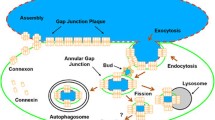Abstract
In gap junctions, identical membrane proteins are linked up in pairs (dyads) that bridge the extracellular space between two apposed cell membranes1,2. Typically, several thousand of these dyads are aggregated in the plane of the membranes and form a junctional plaque with a distinct boundary. The question thus arises as to what maintains the dyads in an aggregated state. From a statistical mechanical analysis of the positions of dyads in a freeze-fracture electron micrograph, we report here that the aggregates are not maintained by an attractive force between pairs of dyads, but probably by the minimization of the repulsive force between apposed membranes. On the basis of this analysis we present a model for the structure of mature gap junctions as well as certain aspects of the formation and disassembly of gap junctions.
Similar content being viewed by others
References
Loewenstein, W. R. Physiol. Rev. 61, 829–913 (1981).
Bennett, M. V. L. & Goodenough, D. A. Neurosci. Res. Prog. Bull. 16, 415 (1978).
Heuser, J. E. & Reese, T. S. in The Neurosciences Fourth Study Program (eds Schmitt, F. O. & Worden, F. G.) (MIT Press, Cambridge, Massachusetts, in the press).
Raviola, E., Goodenough, D. A. & Raviola, G. J. Cell Biol. 87, 273–279 (1980).
Meller, K. Anat. Embryol. 163, 321–330 (1981).
Tadvalkar, G. & Pinto da Silva, P. J. Cell Biol. 96, 1279–1287 (1983).
Peracchia, C. & Peracchia, L. L. J. Cell Biol. 87, 719–727 (1980).
Hill, T. L. Statistical Mechanics Ch. 6 (McGraw-Hill, New York, 1956).
Markovics, J., Glass, L. & Maul, G. G. Expl Cell Res. 85, 443–451 (1974).
Perelson, A. S. Expl Cell Res. 112, 309–321 (1978).
Pearson, T. L., Chan, S. I., Lewis, B. & Engelman, D. M. Biophys. J. 43, 167–174 (1983).
Unwin, P. N. T. & Zampighi, G. Nature 283, 545–549 (1980).
Marcelja, S. Biochim. biophys. Acta 455, 1–7 (1976).
Owicki, J. C. & McConnell, H. M. Proc. natn. Acad. sci. U.S.A. 76, 4750–4754 (1979).
Edelman, J. B. thesis, California Inst. Technol., Pasadena (1978).
Goodenough, D. A. Cold Spring Harb. Symp. quant. Biol. 40, 37–43 (1976).
Rand, R. P. A. Rev. Biophys. Bioengng 10, 277–314 (1981).
Preus, D., Johnson, R. & Sheridan, J. J. ultrastruct. Res. 77, 248–262 (1981).
Johnson, R., Hammer, M., Sheridan, J. & Revel, J. P. Proc. natn. Acad. sci. U.S.A. 71, 4536–4540 (1974).
Author information
Authors and Affiliations
Rights and permissions
About this article
Cite this article
Braun, J., Abney, J. & Owicki, J. How a gap junction maintains its structure. Nature 310, 316–318 (1984). https://doi.org/10.1038/310316a0
Received:
Accepted:
Issue Date:
DOI: https://doi.org/10.1038/310316a0
- Springer Nature Limited
This article is cited by
-
Morphological alterations of gap junctions in phalloidin-treated rat livers
Journal of Gastroenterology (1994)





